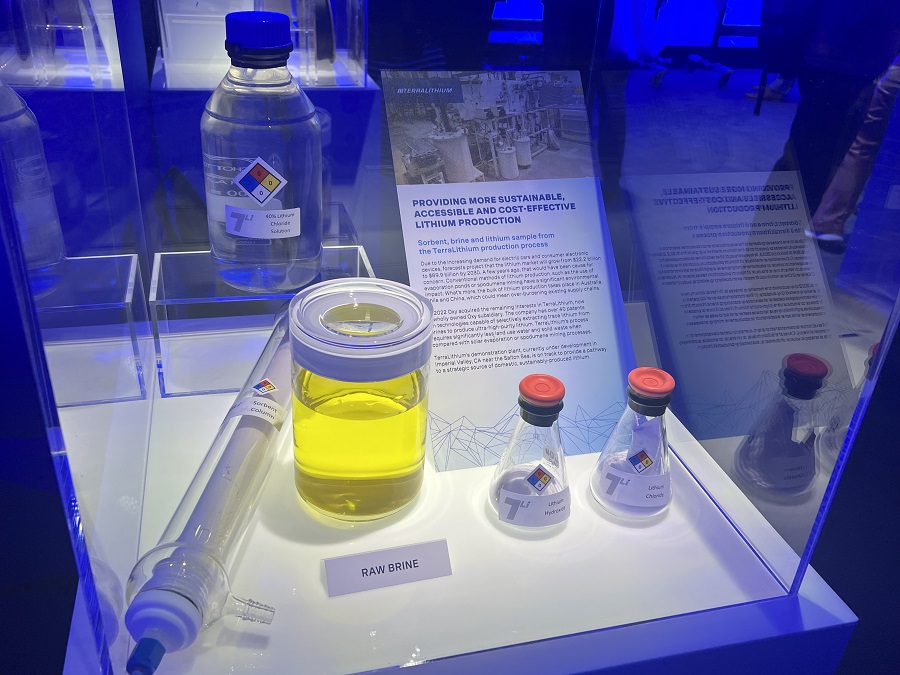
Jeff Alvarez, president of Occidental’s TerraLithium, discusses direct lithium extraction March 19 with Rob Zeller, vice president of technology for Occidental’s Low Carbon Ventures (center), and Pure Lithium CEO Emilie Bodoin during CERAWeek by S&P Global. (Source: Hart Energy)
With oil and gas subsurface and chemical expertise in hand, an extensive patent portfolio and plenty of leasehold, Occidental Petroleum is primed to grow its lithium business taking a “build, own and operate” approach.
Occidental is keeping pace with other E&Ps, most notably Exxon Mobil Corp., as a potential supplier of lithium.
Having merged intellectual property and technical knowhow from Simbol Material, a now defunct lithium tech startup and Occidental OxyChem and wholly owned subsidiary TerraLithium, the company has advanced technology that extracts lithium salts from brine using an adsorbent-type direct lithium extraction (DLE) method.
“I think our adsorbent is ready for prime time. We’re already producing commercial scale quantities today, … and we’re prepared to go to market sort to speak,” Rob Zeller, vice president of technology for the company’s Low Carbon Ventures, said during a March 19 session during CERAWeek by S&P Global.
The adsorbent essentially pulls the lithium out of so-called “nasty” concentrated brine, which requires pretreatment and purification; then it’s run through an electrolysis cell and ultimately transformed into battery-grade lithium and other sellable products.

“It can be hot. It can be at 105 degrees centigrade like a geothermal brine. It can be a produced water brine at 80 degrees centigrade,” Zeller said about the brine. “And the advantage of an adsorbent or an adsorbent-type process is you don’t need acid to regenerate the adsorbent. Acid is troublesome downstream, meaning you got to neutralize it in order to make your other processes. So, it simplifies the process.”
Plus, it uses inexpensive raw materials, he said.
Zeller noted that the technology has been around for a while, but Occidental has put its own technological twist on it to improve capacity and selectivity.
Occidental, experienced with salty water from experience in oil and gas production, formed the TerraLithium joint venture with All-American Lithium in 2019. Occidental is deepening itself into the lithium space amid continued attention on the lightweight metal’s role in the global push toward lower-carbon energy and emissions reduction efforts.
Forming partnerships
Lithium is a key ingredient for rechargeable batteries used to power items such as laptops, cell phones and—most notably for the energy transition—energy storage and electric vehicles (EVs).
The U.S. has identified an estimated 12 million tons of lithium resources in the nation from continental, geothermal and oilfield brines as well as claystone and igneous rock, according to the U.S. Geological Survey. However, the nation—home to only one lithium mine—remains heavily dependent on foreign countries to meet its supply needs. Efforts are underway to boost domestic supplies of critical materials and manufacturing capacity as companies like Occidental’s TerraLithium add to their offerings, partnering with other lithium industry players to meet needs today with an eye on the future.
Just last week, Pure Lithium, a Boston-based lithium metal battery technology company, announced the completion of a $15 million investment from Occidental’s Low Carbon Ventures. The company says its novel Brine to Battery extraction technology creates electrodes for batteries in one day without excess lithium, cobalt, nickel, manganese and graphite. Occidental and Pure Lithium have formed a partnership.
“What we do is take a brine that has [gone] through Oxy’s [Occidental] pretreatment type of process, cleaned up, and before it goes to a compound—a carbonate or hydroxide—we take that and we turn it into a lithium metal anode, which is a whole battery anode for a next generation battery,” Pure Lithium CEO Emilie Bodoin said. “This partnership basically takes care of all of the work of getting it out of the ground, putting resources back in the ground, and we get it in our beautiful cell and make it into a battery ready technology.”
Moving forward
Looking to scale and move toward commerciality, Occidental is pushing forward plans for a demonstration plant.
“We’ve developed a front-end engineering design for a demonstration plant. We are poised to do some use long lead time equipment, effectively habilitating the electrolysis cell for operation here,” Zeller said. “Hopefully, we’ll have some product produced by the end of the year. It’s what I've challenged the team to go do. And so, it's all actively going on with regard to TerraLithium technology.”
A goal is to further de-risk the technology. Sometimes processes work well in the lab but challenges surface when scaling up.
“You have to be able to have internal recycle streams to figure out what the buildup of impurities are so you understand the material’s compatibility and understand what the impact is on quality,” Zeller said.
Jeff Alvarez, president of Occidental’s TerraLithium sees parallels between the oil, gas and chemicals business and the lithium business. He spoke about the company’s business model.
“Our starting premise is we’ll build, own and operate these plants and facilities,” acquiring leases, getting the brine and resources to make different products, and then integrate with companies downstream, Alvarez said. “But we also have the opportunity to partner with different companies that may be focused on one piece. They may have access to the brine and want us to build a plant or turn it into lithium hydroxide. We have unique abilities and IP to do that. Or we could also license it [technology].”
Though Occidental sees multiple pathways to commercialization, Alvarez said its bias is toward building, owning and operating. “But we can also go down those other paths if that’s what makes the most sense,” he said.
Speaking on costs and economics, Alvarez said the company thinks the economics are robust across the entire value chain. “We believe low cost with a good product win.”
Recommended Reading
Elk Range Royalties Makes Entry in Appalachia with Three-state Deal
2024-03-28 - NGP-backed Elk Range Royalties signed its first deal for mineral and royalty interests in Appalachia, including locations in Pennsylvania, Ohio and West Virginia.
SilverBow Gears Up for Proxy Fight with Kimmeridge
2024-04-09 - Both SilverBow Resources and Kimmeridge Energy Management have proposed a slate of candidates for the board of directors with a vote set for May 21.
Marketed: Paloma Natural Gas Eagle Ford Shale Opportunity in Frio County, Texas
2024-02-16 - Paloma Natural Gas has retained EnergyNet for the sale of a Eagle Ford/ Buda opportunity in Frio County, Texas.
Kodiak Gas Services Closes $850MM Deal for CSI Compressco
2024-04-02 - Kodiak Gas Services’ acquisition of CSI Compressco was financed as an all-equity transaction valued at approximately $854 million, including assumption of $619 million in debt.
Kimmeridge Withdraws SilverBow Deal to Focus on E&P’s ‘Broken’ Board
2024-04-16 - Investment firm Kimmeridge said it had withdrawn its offer to combine its Eagle Ford E&P with SilverBow Resources as it promotes a slate of independent directors for SilverBow’s board at the company’s May annual meeting.





